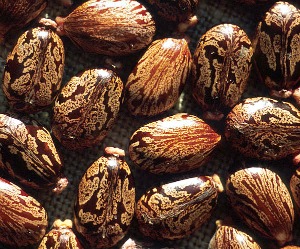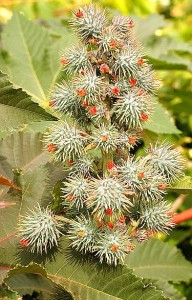 The Castor-Oil Plant (Ricinus communis) yields beans rich in oil which, when processed, can be used for medicine and cosmetics. This oil can also be used as a substitute for fossilized fuels or bio-diesel, plastics, lubricants in aviation, aviation fuel, and much, much more. In fact, over 700 varied uses for it are listed.
The Castor-Oil Plant (Ricinus communis) yields beans rich in oil which, when processed, can be used for medicine and cosmetics. This oil can also be used as a substitute for fossilized fuels or bio-diesel, plastics, lubricants in aviation, aviation fuel, and much, much more. In fact, over 700 varied uses for it are listed.
Locally, the plant is known as “tangan-tangan”. Planted in yards, old folks use the seed as a purgative; the bark and roots for treating skin diseases and burns; and the oil for lighting purposes.
India, China, Brazil, and Thailand are the countries which produce castor-oil beans that are used for processing many products. In China, there are about 20 processing factories, but only about 200,000 tons of seed are produced; they need 400,000 tons annually.
In Nueva Ecija, it is now the “in” plant for propagation. It is planted to at least 200 hectares now in the towns of Laur, Bongabon, Rizal, and Gen. Tinio, and in Palayan City. Plantation areas may reach 1,000 hectares as lands for planting are being scouted and evaluated by the organization behind the production project.
Dr. Eliseo Ruiz, chief executive officer of the Organic Hybrid Castor Bean Commercial Production Project, said that tangan-tangan seed is a source of castor oil. The seed’s oil content is up to 55 percent or more. Dr. Ruiz noted that the plant is a shrub which is very adaptable in tropical or hot and humid regions.
How to grow Castor-Oil Plant
THE PLANT

Tangan-tangan is a robust suckering perennial shrub that can grow from one to five meters in height. Its leaves are large and can span over 50 centimeters across; they are deeply lobed, toothed, ovate, and bronze-red in color.
It flowers as early as 52 days from planting. Flowering occurs most of the year in dense terminal clusters or inflorescences. It has female and male flowers, with the former just above the latter but without petals. Each male flower has a cluster of stamens that “smoke” as they shed their pollen when the wind blows. The female contains the spiny ovary which develops into seed capsules, and a bright red structure with feathery branches which receive pollen from the male flowers.
Each seed capsule has three sections or carpels, each of which contain one seed. As the carpels dry, the seeds are ejected. The seeds are a little larger than a pinto bean ( a type of mottled kidney bean) with designs that are beautiful and intricate. No two seeds have exactly the same design pattern due to genetic variations.
As attractive as the seeds are, they are among the most deadly seeds and can be fatal to those who eat it. Cases of children eating tangan-tangan seeds out of curiosity or because of their attraction to the beautiful designs and their similarity to edible beans are still being reported. Almost always, the children eating them die.
CULTURAL MANAGEMENT
- Propagate seeds in plastic bags with potting soil composed of 25% decomposed rice hull or sawdust, 50% topsoil, and 25% organic fertilizer.
- Spray seedlings with foliar fertilizer at the rate of 0.67% mixed with 46-0-0 at the rate of 1% solution once a month. Watch out for any signs of the presence of pests, and apply appropriate pesticides when necessary.
- Plant the seedlings in sandy to sandy-to-loam soil with good drainage when they are 30-35 days old or when the growing plants are 30 cm tall.
- Plant at a distance of 1.5 x 1.5 meters. The holes should 35 to 40 cm in diameter and 40 to 45 cm deep. Place one kilogram of organic fertilizer per hole.
- Prune the tops of the growing plant to encourage branching. More branches means more fruiting points.
- Apply side dressing of one kilogram of organic fertilizer every six months.
- Irrigate as needed. Tangan-tangan does not need much water, though.
- Spray seedlings with foliar fertilizer at the rate of 0.67% mixed with muriate of potash at the rate of 1% solution once every quarter if the plants have started fruiting. This will enhance fruiting and will help the plant produce quality seeds with maximum oil content.
- Apply recommended crop protection chemicals following the manufacturer’s recommendation if necessary. The normal pests of the castor-oil plant are spider mites and some sucking insects attacking the leaves. The plant is not normally bothered by birds or rodents, nor by fungal-borne diseases as it contains a toxic substance that acts as a repellant.
- Harvest the fruit when it ripens or when the color of the pod or capsule is cream or yellow.
Source: www.trc.dost.gov.ph; Photos: en.wikipedia.org
Hello good day!
I am interested in tangan tangan production I have 2 hectars which i intent to plant tangan tangan, but my predicament is where im going to sell my tangan tangan products.
Please reply me where to sell with in davao city or even region 11 and region 12
Thank you
Good day!
heard about tangan tangan from a friend.I have read a few and I’m interested in production.i have two options and would like to learn more. please email me. i am willing to hear more about tangantangan.thank you and God bless,